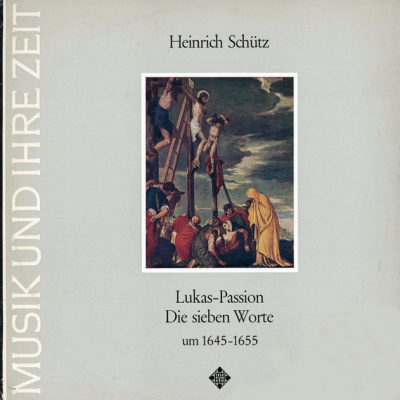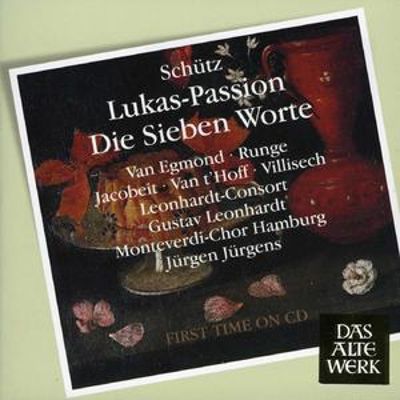 |
|
1 LP -
SAWT 9467-A - (p) 1965
|
 |
| 1 CD -
2564-69612-8 - (c) 2008 |
|
LUKAS-PASSION
| DIE SIEBEN WORTE
|
|
|
|
|
|
|
|
| Heinrich SCHÜTZ (1585-1672) |
Die
sieben Worte unsers lieben Erlösers und
Seligmachers Jesu Christi, so er am
Stamm des Heiligen Creutzes gesprochen,
SWV 478 |
|
18' 08" |
|
|
-
Introitus: "Da Jesu an dem Kreuze stund"
(Chorus) |
2' 13" |
|
A1 |
|
- Symphonia a 5
|
1' 32" |
|
A2 |
|
-
"Und es war um die dritte Stunde" (4
Evangelisten, Schächer, Jesus)
|
10' 48" |
|
A3 |
|
-
Symphonia a 5
|
1' 39" |
|
A4 |
|
-
Conclusio: "Wer Gottes Marter in Ehren
hat" (Chorus) |
1' 56" |
|
A5 |
|
Historia
des Leidens und Sterbens unsers Herrn
und Heylandes Jesu Christi nach dem
Evangelisten St. Lucam (Lukas-Passion),
SWV 480 |
|
33' 26" |
|
|
-
Introitus: "Das Leiden unsers Herren Jesu
Christi" (Chorus) |
1' 15" |
|
A6 |
|
- "Es
war aber nahe das Fest der süßen Brot"
(Evangelista, Jesus, die Jünger, Petrus)
|
9' 27" |
|
A7 |
|
-
"Und er ging hinaus nach seiner Gewohnheit
and den Ölberg" (Evangelista, Jesus) |
1' 35" |
|
B1 |
|
- "Da
er aber noch redete" (Evangelista, Jesus,
die Jünger)
|
1' 59" |
|
B2 |
|
-
"Sie griffen ihn aber und führeten ihn"
(Evangelista, Ancilla, Petrus, 1. u. 2.
Knecht)
|
1' 33" |
|
B3 |
|
-
"Die Männer aber, die da Jesum hielten"
(Evangelista, die Juden, Hohenpriester und
Schriftgelehrte, Jesus)
|
2' 38" |
|
B4 |
|
-
"Und der ganze Haufe stund auf und
führeten ihn für Pilatum" (Evangelista,
Hohepriester und Schriftgelehrte, Pilatus,
Jesus)
|
2' 06" |
|
B5 |
|
- "Da
aber Pilatus Galiläam hörete"
(Evangelista)
|
1' 04" |
|
B6 |
|
-
"Pilatus aber rief die Hohenpriester und
die Obristen" (Evangelista, Pilatus, die
ganze Schar)
|
2' 32" |
|
B7 |
|
-
"Und als sie ihn hinführeten"
(Evangelista, Jesus, die Obersten, die
Kriegsknechte, 1. u. 2. Schächer)
|
5' 15" |
|
B8 |
|
-
"Und es war um die sechste Stunde"
(Evangelista, Jesus, Hauptmann) |
1' 16" |
|
B9 |
|
-
"Und alles Volk, das dabei war und zusahe"
(Evangelista) |
1' 29" |
|
B10 |
|
-
Beschluß: "Wer Gottes Marter in Ehren hat"
(Chorus) |
1' 37" |
|
B11 |
|
|
|
|
|
Sieben
Worte:
Max van Egmond, baritone (Jesus
[Tenor II])
Irmgard Jacobeit, soprano (Evangelist [Sopran])
Bert van t'Hoff, tenor (Evangelist
[Altus], Schächer zur Linken)
Peter
Christoph Runge, baritone
(Evangelist [Tenor I])
Jacques Villisech, bass
(Evangelist [Bass], Schächer zur Rechten)
MONTEVERDI-CHOR
HAMBURG
LEONHARDT-CONSORT
- Marie Leonhardt & 1 other, Violine
- Dijke Koster, Violoncello (Giovanni
Battista [II] Guadagnini, 1749)
- Veronika Hampe & 2 others, Viola
da gamba
- Gustav Leonhardt, Orgel (Klaus
Becker, Kupfermühle 1961)
Jürgen JÜRGENS, Gesamtleitung
|
Lukas-Passion:
Max van Egmond,
baritone
(Jesus)
Peter Christoph Runge, baritone
(Evangelista)
Mitglieder des Monteverdi-Chores,
Petrus, Pilatus, Ancilla, 1. und 2.
Knecht, 1. und 2. Schächer, Hauptmann
MONTEVERDI-CHOR HAMBURG
(Die Jünger, hohepriester und
Schriftgelehrte, die Juden, die ganze Schar,
Chor)
Jürgen JÜRGENS,
Gesamtleitung
|
|
|
|
|
|
Luogo
e data di registrazione |
|
Studio Teldec,
Hamburg (Germany) - Novembre 1964
|
|
|
Registrazione: live
/ studio |
|
studio |
|
|
Producer |
|
-
|
|
|
Prima Edizione LP |
|
Telefunken "Das Alte
Werk" | SAWT 9467-A | 1 LP -
durata 52' 13" | (p) 1965 | ANA
|
|
|
Edizione CD |
|
Warner Classics |
LC 04281 | 2564-69612-8 | 1 CD -
durata 52' 13" | (c) 2008 | ADD |
|
|
Cover
|
|
"The Crucifixion",
after a painting by Paolo
Veronese.
|
|
|
Note |
|
-
|
|
|
|
|
Heinrich
Schütz’s Passion Oratorio
“The Seven Words of our Dear
Redeemer and Saviour Jesus
Christ, as he spoke on the
stem of the Holy Cross,
quite freely set by Master
Heinrich Schütz, Conductor
to the Elector of Saxony“
has come down to us only in
an undated set of
handwritten choral parts of
that time. Schütz presumably
wrote the work in 1645,
towards the end of the
Thirty Years War, and at the
time when his Court Chapel
was at its lowest state of
decline. As a motto, he
prefaced it with a verse of
a hymn intended to relate
the Act of Salvation
directly to the believing
listener, and that was not
without a sombre topicality
at the end of the great war:
“If
you live for the world,
then you are dead
And
afflict Christ with
pain,
But
if you die in his red
wounds,
Then
He lives in your heart.“
The
text of the work, summarized
from the four gospels into
the “sacred“ number of the
seven dying words, already
had a venerable tradition
that had assumed artistic
shape in the mediaeval hymns
“Patris sampienta“ and “Da
Jesus an dem Kreuze stund“
(When Jesus was on the
Cross). Schütz followed this
tradition by using the first
and last verses of the hymn
,,Da Jesus an dem Kreuze
stund“ (without its melody)
together with an
instrumental “Symphonia“
following the first verse
and repeated before the
last, as a framework for the
Seven Words proper, these of
course strictly following
the biblical text. The ’Introitus’
and ’Conclusio’ (the two
hymn verses), are two
five-part motet movements of
almost exactly equal length;
the “Symphonia“ is likewise
in motet character, although
written as a compact,
chordal, five-part
instrumental. movement. The
Seven Words display exactly
the same distribution of
voices, divided, however,
between the “roles“ of the
Passion story. The words of
Jesus are sung by the second
tenor, accompanied by two
instrumental parts; the
words of the thieves are
sung by the alto and bass;
the evangelist passages are
sung alternately by the
soprano, alto and first
tenor soloists, or in motet
style by a vocal quartet
without the second tenor.
Dramatic presentation of the
action and deliberately
unrealistic stylization in
the narrative evangelist
passages, in accordance with
the tradition and the
liturgical dignity of the
subject, are thus perfectly
balanced. The continuo, used
throughout the work, is the
technical devise used for
holding all the various
sections together to form an
entity.
Just as in the case of this
formal scheme, the work’s
stylistic details clearly
display efforts to combine
musical and liturgical
traditions of Passion
composition with the modern
formative elements of
monody, and to mediate
between solemn, ritual
narration and dramatic
depiction. Thus the writing
in the hymn verses and the
evangelist quartet passages
is of a strict, restrained
intensity that is never
excessive and madrigalesque,
being even more restrained
than the writing in the
“Sacred Choral Music“
composed around the same
time. Again, the
instrumental parts to the
words of Jesus do not only
serve to underline the
spiritual core of the whole
and (quite similarly to
Bach's St. Matthew Passion)
surround the Saviour with a
“halo“, but also to bind the
monodic power of expression
of the vocal part into the
fixed “turns of phrase“ and
the strict rules of
composition of a quasi-motet
movement. The words of the
thieves and the solo
sections of the evangelist
part are also clearly
separated by such
restrictions from the model
of free Italian monody and
even from the dramatic tone
of the recitatives in the
later “Christmas Story“. How
magnificently and with what
variety, but also with what
dignity and solemn earnest
the expression of this work
develops, precisely under
such strict limitations, the
attentive listener will not
fail to hear, quite
independently of any
historical and technical
knowledge.
A similar liturgical
austerity is displayed even
more clearly in the three
late Passions of the master,
of which that based on St.
Luke’s gospel is the only
one not dated. It might
already have been composed
shortly after 1653, thus in
the seventh decade of the
composer’s life. All
instruments - even the
continuo - have been banned
from this work in accordance
with the venerable tradition
of “quiet“ music in Holy
Week. An outer framework is
provided by two motet-like
choruses - a “Title“ as an
‘Introitus‘ and again the
last verse of “Da Jesus an
dem Kreuze stund“ as the
conclusion. These two
choruses recall the
structure of the “Seven
Words“, but they are not in
five parts. as was customary
at that time, but only in
four, and are briefer and
more restrained in
expression than those of the
other work. The action
choruses of the Passion
story, on the other hand,
also in four parts, are of a
magnificent forcefulness and
dramatic quality in their
expression, although within
a restricted space and with
the most modest means of
composition. Finally the
words of Christ, of the
evangelist and of the other
individual characters of the
Passion story are heard in
unaccompanied recitatives
with no rhythmic values in
their notation. These are
based on the liturgical
recitation tones of the
gospel readings for Holy
Week, but the schematic
formulas of these are
transformed by
rearrangements of notes,
little melismata and
cadenzas into a musical
“speech“ that
is just as subtle as it is
expressive. This recitative
tone is quite unique
(although it did not arise
without historical models),
and recurs in Schütz’s St.
Matthew and St. John
Passions; it reveals more
than anything else how the
composer developed the
greatest wealth of
expression from the severest
limitation of his means.
Stylization akin to liturgy
and dramatic expressiveness,
supreme spirituality and
profoundest feeling come
together in the Passions of
Schütz to form a synthesis
that could probable be
achieved only by the
greatest German composer.
before Bach, and even by him
only at the end of his life.
In our recording the choral
singing of the disciples (11
vocalists) the high-priests,
scholars and chief-pontiffs
is performed exclusively by
male voices (including
falsetto voices). The two
accompanying choirs and the
choirs of the Jews and the
crowd are sung by both
female and male vocalists of
the Monteverdi Choir.
|
  |
|
|